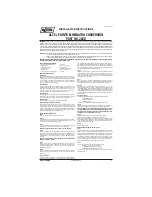
Tire identification marks
Tire size
255/50 R 19 103 Y
255: nominal width in mm
50: aspect ratio in %
R: radial tire code
19: rim diameter in inches
103: load rating, not for ZR tires
Y: speed rating, before the R on ZR tires
Speed letter
T = up to 118 mph/190 km/h
H = up to 131 mph/210 km/h
V = up to 150 mph/240 km/h
W = up to 167 mph/270 km/h
Y = up to 186 mph/300 km/h
Tire Identification Number
DOT code: DOT xxxx xxx 3508
xxxx: manufacturer code for the tire brand
xxx: tire size and tire design
3508: tire age
Tires with DOT codes meet the guidelines of the
U.S. Department of Transportation.
Tire age
DOT … 3508: the tire was manufactured in the
35th week in 2008.
Recommendation: regardless of wear, replace
tires at least every 6 years.
Uniform Tire Quality Grading
Quality grades can be found where applicable
on the tire sidewall between tread shoulder and
maximum section width.
For example: Treadwear 200; Traction AA;
Temperature A
DOT Quality Grades
Treadwear
Traction AA A B C
Temperature A B C
All passenger car tires must conform to Federal
Safety Requirements in addition to these
grades.
Treadwear
The treadwear grade is a comparative rating
based on the wear rate of the tire when tested
under controlled conditions on a specified gov‐
ernment test course. For example, a tire graded
150 would wear one and one-half, 1 g, times as
well on the government course as a tire graded
100. The relative performance of tires depends
upon the actual conditions of their use, however,
and may depart significantly from the norm due
to variations in driving habits, service practices
and differences in road characteristics and cli‐
mate.
Traction
The traction grades, from highest to lowest, are
AA, A, B, and C.
Those grades represent the tire's ability to stop
on wet pavement as measured under controlled
conditions on specified government test surfa‐
ces of asphalt and concrete. A tire marked C may
have poor traction performance.
The traction grade assigned to this tire is based
on straight-ahead braking traction tests, and
does not include acceleration, cornering, hydro‐
planing, or peak traction characteristics.
Temperature
The temperature grades are A, the highest, B,
and C, representing the tire's resistance to the
generation of heat and its ability to dissipate
heat when tested under controlled conditions
on a specified indoor laboratory test wheel. Sus‐
tained high temperature can cause the material
of the tire to degenerate and reduce tire life, and
excessive temperature can lead to sudden tire
failure. The grade C corresponds to a level of
performance which all passenger car tires must
meet under the Federal Motor Vehicle Safety
Standard No. 109. Grades Band A represent
higher levels of performance on the laboratory
test wheel than the minimum required by law.
Seite 229
229
Online Edition for Part no. 01 41 2 604 413 - 03 10 500
Reference
Mobility
Communication
Entertainment
Navigation
Driving tips
Controls
At a glance
Summary of Contents for 535I
Page 2: ......
Page 10: ...10 Online Edition for Part no 01 41 2 604 413 03 10 500 ...
Page 30: ...30 Online Edition for Part no 01 41 2 604 413 03 10 500 ...
Page 144: ...144 Online Edition for Part no 01 41 2 604 413 03 10 500 ...
Page 152: ...152 Online Edition for Part no 01 41 2 604 413 03 10 500 ...
Page 170: ...170 Online Edition for Part no 01 41 2 604 413 03 10 500 ...
Page 202: ...202 Online Edition for Part no 01 41 2 604 413 03 10 500 ...
Page 222: ...222 Online Edition for Part no 01 41 2 604 413 03 10 500 ...
Page 254: ...254 Online Edition for Part no 01 41 2 604 413 03 10 500 ...
Page 276: ......
















































